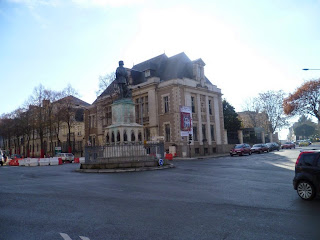Angers, Departamento de Maine y Loira, Región
Países del Loira. Angers es la antigua capital de Anjou. La ciudad está
clasificada como patrimonio de la Unesco. La ciudad se asienta sobre la rivera
del Maine, a pocos kilómetros del Loira. Angers es un puerto antiguo fluvial de
gran actividad. Se tiene noticias de Angers como oppidum romano en tiempos de
la conquista. La ciudad toma el nombre de los primitivos habitantes celtas, los
Andes, por lo que los romanos la llamaron Civitas Andecavorum, y de ahí viene
el nombre actual. En el siglo III se construye una muralla que rodea 9 ha y que
actualmente es conocida como La Cité. Se menciona al primer obispo sobre el año
372, desde la elección de Martin de Tours. La vida monástica penetra en la
ciudad a partir del siglo VI. Los reyes Clodoveo II y Thierry III fundan la
abadía de Saint Serge en el siglo VII. Desde el siglo IX, Carlos el Calvo crea
una frontera en la zona para proteger los territorios de los ataques normando y
bretones. En el siglo X los condes de Anjou fundan castillos para mejor
proteger los territorios. En 1356 el condado pasa a ser ducado. A partir de
1480 el título se incorpora a los de la corona de Francia, por eso Felipe V,
rey de España y primer borbón de la dinastía española llega desde Francia con
el título de Duque de Anjou.
Angers, Maine-et-Loire department, Pays de la
Loire region. Angers is the old capital of Anjou. The city is listed as Unesco
heritage. The city sits on the banks of the Maine, a few kilometers from the
Loire. Angers is an old fluvial port of great activity. There is news of Angers
as a Roman oppidum in times of the conquest. The city takes its name from the
early Celtic inhabitants, the Andes, so the Romans called it Civitas
Andecavorum, and hence the current name. In the third century a wall around 9
ha was built and is now known as La Cité. It is mentioned the first bishop of
the year 372, since the election of Martin of Tours. The monastic life enters
the city from the sixth century. Clodoveo II and Thierry III kings founded the
abbey of Saint Serge in the seventh century. From the ninth century, Charles
the Bald creates a border in the area to protect the territories of the Norman
attacks and Britons. In the tenth century the counts of Anjou founded castles
to better protect the territories. In 1356 the county becomes duchy. From 1480
the title was incorporated into the Crown of France, and that is why Felipe V,
king of Spain and the first Spanish Bourbon comes from France with the title of
Duke of Anjou.




